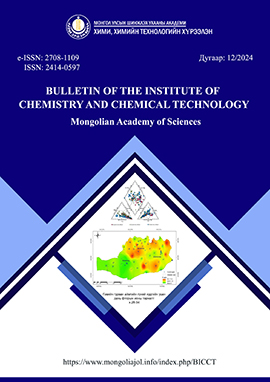Fluoride ion study of deep well water in the Gobi region
DOI:
https://doi.org/10.5564/bicct.v12i12.3938Keywords:
groundwater, chemical composition, well water, fluorideAbstract
This study aimed to determine the fluoride ion content of deep well water in the Gobi region, compare it with established standards, and identify its origin. Within the scope of the work, we examined the physical and chemical parameters, as well as fluoride ion content of 144 deep well water samples collected from three provinces: Dundgobi, Dornogobi, and Umnugobi. The results were compared with the requirements set by the Mongolian drinking water standard MNS 0900:2018. According to measured pH values, the environment of the analyzed deep well water samples ranged from alkaline to neutral, whereas the hardness varied from very soft to very hard. It was also found that 63.2% percent of the samples did not meet the requirements of the drinking water standard MNS 0900:2018 for fluoride ion content. Specifically, 64.8% of the groundwater samples in Dundgobi province (F- , 0.7-7.18 mg/L), 56.8% in Dornogobi province (F- , 0.04-4.62 mg/L), and 17.4% in Umnugobi province (F- , 0-5.6 mg/ L) exceeded the maximum permissible limit specified in the MNS standard. The analysis revealed that deep well water used as drinking water in the three provinces of the Gobi region falls into multiple mixed composition categories, including hydrocarbonate -sodium, hydrocarbonate-calcium, magnesium, sulfate-sodium, calcium, chlorine, and sulfate-sodium types. Notably, the hydrocarbonate-sodium (HCO3--Na+) type water was found to have a high fluoride content. Due to the presence of multifidous mineral and rock deposits in the three provinces of the Gobi region, it was determined that the water from deep wells undergoes water-rock interactions, and the chemical composition of the water, especifically the fluoride ion content, depend on the geological formations as well as the chemical composition of rocks of the surrounding environment.
Говийн бүсийн гүний худгийн усны фторын ионы судалгаа
Бид энэ удаагийн судалгаагаар говийн бүсийн гүний худгийн усны фторын ионы агуулгыг тодорхойлж, стандарттай харьцуулан дүгнэлт өгөх, гарал үүслийг тодорхойлох зорилгоор энэхүү ажлыг хийж гүйцэтгэв. Энэхүү судалгаанд Дундговь, Дорноговь, Өмнөговь аймгуудын 144 гүний худгийн усны физик-химийн үзүүлэлт, фторын ионы агуулгыг Монгол улсад мөрдөгдөж байгаа ундны усны MNS 0900:2018 стандарт шаардлагатай харьцуулан тодорхойлсон болно. Судалгаанд хамрагдсан гүний худгийн ус нь саармагаас шүлтлэг орчинтой, маш зөөлнөөс маш хатуу усны ангилалд хамаарагдаж байгаа бөгөөд фторын ионы агуулгаараа 63.2% ундны усны стандарт MNS 0900:2018 шаардлага хангахгүй байгааг тодорхойлов. Үүнээс Дундговь аймгийн гүний худгийн усанд (F- 0.7-7.18 мг/л) буюу 64.8%, Дорноговь аймгийн гүний худгуудын усанд (F - 0.04-4.62 мг/л) буюу 56.8%, Өмнөговь аймгийн худгийн усанд (F- 0-5.6 мг/л) буюу 17.4% нь тус тус MNS стандартын зөвшөөрөгдөх дээд агууламжаас хэтэрсэн байна. Мөн говийн бүсийн 3 аймгийн унданд хэрэглэж буй гүний худгийн ус нь гидрокарбонат-натри, гидрокарбонат-кальци, магни, сульфат-натри, кальци, хлор, сульфат-натрийн төрлийн холимог найрлагатай усны ангилалд хамаарагдаж байгаа бөгөөд HCO3- -Na+ төрлийн усанд фтор өндөр агуулгатай байгааг тодорхойлов. Говийн бүсийн 3 аймаг эрдэс, чулуулгийн орд ихтэйн улмаас гүний худгуудын ус нь ус, чулуулгийн харилцан үйлчлэлд орж усны химийн найрлага, фторын ионы агуулга тухайн орчны геологийн тогтоц болон чулуулгаас хамаарч байгааг тогтоов.
Түлхүүр үг: газрын доорх ус, химийн найрлага, гүний худаг, фтор
Downloads
323
Downloads
Published
How to Cite
Issue
Section
License
Copyright (c) 2024 Gombosuren Odontuya, Amarjargal Ichinnorov, Otgonbayar Khureldavaa, Ganpurev Dulamsuren, Battulga Dariimaa, Dolgorjav Oyuntsetseg

This work is licensed under a Creative Commons Attribution 4.0 International License.
Copyright on any research article in the Bulletin of the Institute of Chemistry and Chemical Technology, MAS is retained by the author(s).
The authors grant the Bulletin of the Institute of Chemistry and Chemical Technology, MAS a license to publish the article and identify itself as the original publisher.

Articles in the Bulletin of the Institute of Chemistry and Chemical Technology, MAS are Open Access articles published under a Creative Commons Attribution 4.0 International License CC BY.
This license permits use, distribution and reproduction in any medium, provided the original work is properly cited.

